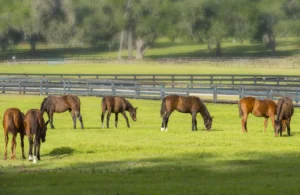What is a Yearling?
In the equine world, the term yearling refers to a horse that is between 12 and 24 months old, essentially a young horse that has completed its first year of life but hasn’t yet turned two. While yearlings are technically still considered adolescents, they are well on their way to becoming more mature and physically developed animals.
During this stage, horses experience significant growth. Their bodies are rapidly developing, and their bones, muscles, and joints are strengthening. Yearlings often undergo a period of rapid physical transformation, which can include a change in their coat and the development of more defined features like their withers, neck, and hindquarters.
Behaviorally, yearlings can be full of energy and curiosity. They may start to show signs of their personalities, including varying levels of boldness, independence, or playfulness. This is also a time when young horses begin to show their potential for training and performance, especially in disciplines like racing or show jumping. Though they’re not ready for intense work, many trainers begin to introduce basic groundwork and early training concepts to prepare them for their future roles.
In terms of breeding, yearlings are often sold at auctions or to private buyers, with breeders and trainers seeking horses that exhibit promising traits for racing, sport, or breeding. The yearling stage is a crucial one in a horse’s life, as it marks the beginning of their transition from foal to adult horse.
Overall, yearlings are exciting to watch as they grow and develop, offering a glimpse into what they might become as they continue to mature into their full potential.

FAQs About Yearlings
1. What age is considered a yearling?
A yearling is a horse that is between 12 and 24 months old. It refers to a horse that has completed its first year of life but has not yet reached two years old.
2. How fast do yearlings grow?
Yearlings grow quickly, especially in the first year. They experience significant changes in their body structure, including increased muscle development and growth in height. They typically reach about 80% of their adult height by the time they turn two.
3. Are yearlings ready for training?
While yearlings are still growing, basic groundwork and light training can begin around this age. Most yearlings are introduced to halter training, leading, and other foundational skills. However, more intense work or performance training usually doesn’t start until they are older, around two or three years.
4. How do you care for a yearling?
Caring for a yearling involves providing a balanced diet, regular exercise, and appropriate socialization. Yearlings need plenty of room to move and grow, as well as regular veterinary check-ups to monitor their development. Their diet will consist of hay, grass, and a specialized feed to support their growth.
5. Can a yearling be sold or bought?
Yes, yearlings are often sold at auctions or directly from breeders, especially if they are being raised for specific purposes like racing or sport. Buyers look for yearlings with desirable traits, such as conformation, temperament, and athletic potential.
6. When do yearlings start to mature?
Yearlings are still in the adolescent stage, and their full maturity usually occurs around the age of 3 or 4 years old. This is when their physical and mental development stabilizes, and they are ready for more intensive training and work.




